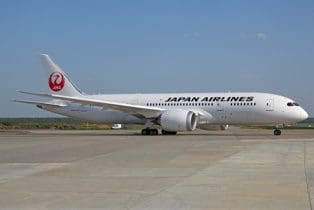 Japan Airlines
Japan Airlines
Japan Airlines will resume flights between Tokyo Narita and Delhi starting January 17, 2026, bringing back a route that’s been dormant for six years and giving travelers a second Tokyo gateway to India’s capital.
The airline will operate the route once daily using Boeing 787-8 aircraft, complementing its existing Haneda to Delhi service. By serving Delhi from both Tokyo airports, JAL is pursuing a dual strategy targeting different passenger segments with distinct travel needs.
Flight JL749 departs Narita at 8:15 PM and arrives in Delhi at 3:00 AM the following day. The return flight JL740 leaves Delhi at 4:35 AM and reaches Narita at 3:10 PM. These timings aren’t random. They’re carefully designed to maximize connecting traffic from North America and Europe.
The evening departure from Narita allows passengers arriving on daytime flights from cities like New York, Los Angeles, or London to connect smoothly to India. The afternoon return gives travelers enough time to catch onward flights to various international destinations, making Tokyo a viable alternative to traditional Middle Eastern hubs.
JAL already operates between Haneda and Delhi, so why add Narita? The answer lies in understanding how Tokyo’s two major airports serve different purposes. Haneda sits closer to downtown Tokyo, about 14 kilometers from the city center, making it ideal for passengers whose trips begin or end in the Japanese capital.
Narita, located roughly 60 kilometers from central Tokyo, handles more international long-haul traffic. It’s JAL’s primary hub for connections between Asia and North America or Europe. The airport matters less for point-to-point travelers but becomes crucial for passengers transferring between continents.
This route represents a comeback. JAL first started flying to Delhi on May 4, 1965, and for decades operated through Narita. Then in late 2019, just before COVID-19 upended global aviation, the airline shifted its Delhi service entirely to Haneda. Narita went dark for India operations, and it’s stayed that way for six years.
Now JAL is betting that demand justifies serving Delhi from both airports simultaneously. The Haneda route targets Japanese tourists visiting India, Indian business travelers heading to Tokyo, students, and families. These passengers care about convenience and proximity to central Tokyo.
The Narita route chases a different crowd: connecting passengers who view Tokyo as a stopover rather than a destination. Think of an Indian software engineer flying to Seattle via Tokyo, or an American family heading to Mumbai through Japan. These travelers don’t mind Narita’s distance from downtown because they’re just transferring between planes.
JAL’s codeshare partnership with IndiGo Airlines, India’s largest domestic carrier, makes this strategy more powerful. A passenger could fly IndiGo from a smaller Indian city like Ahmedabad or Kochi, connect to JAL’s international flight in Delhi, then continue through Tokyo to San Francisco or Vancouver. Having both Narita and Haneda options increases network flexibility.
The move also positions JAL to compete more aggressively against Middle Eastern carriers like Emirates, Qatar Airways, and Etihad, which dominate India to North America traffic through their Gulf hubs. These airlines have invested billions building Dubai, Doha, and Abu Dhabi into massive transfer points. JAL is now offering Tokyo as an alternative.
For travelers, this creates interesting choices. If you’re flying between Tokyo and Delhi as your final destinations, Haneda makes more sense due to its proximity to the city. But if you’re connecting to or from North America, Europe, or other parts of Asia, Narita might offer better timing and options.
The dual-airport approach also provides scheduling redundancy. If one flight fills up, passengers have another option the same day. For business travelers on tight schedules, this flexibility can be valuable, even if it means using a less convenient airport.
From an economic perspective, resuming Narita service signals JAL’s confidence in India-Japan travel demand. Airlines don’t add routes casually. They analyze projected load factors, yield management, and competitive dynamics before committing aircraft and crew. The fact that JAL is willing to operate two daily flights to Delhi suggests strong underlying demand.
India’s growing economy and expanding middle class make it an increasingly important aviation market. Japanese companies have significant business interests in India, while Indian tech workers and students see Japan as an attractive destination. Tourism flows in both directions, though still modest compared to other Asian routes.
The timing of the January 2026 launch falls after the winter holiday season but before spring travel peaks. This allows JAL to test the market during moderate demand periods before committing to sustained year-round operations. If the route performs well initially, frequency could increase.
For Delhi’s Indira Gandhi International Airport, adding back JAL’s Narita service enhances connectivity options. The airport has been working to position itself as a South Asian hub, though it faces stiff competition from Dubai, Singapore, and Bangkok. Having more direct links to major cities helps that ambition.
Japan Airlines’ decision also reflects broader trends in Asian aviation. As Middle Eastern carriers dominate traditional Europe-Asia and Asia-North America routes, Northeast Asian airlines are looking for ways to capture connecting traffic. Tokyo, Seoul, and Taipei are all positioning themselves as transfer alternatives.
Whether this strategy succeeds depends on execution. JAL needs to offer competitive fares, convenient connections, and service quality that justifies routing through Tokyo instead of more established hubs. The airline’s reputation for punctuality and service could be differentiators if they’re marketed effectively.
For now, travelers planning trips between India and North America or Europe have a new option. Starting January 17, Tokyo’s Narita airport rejoins the conversation as a potential connection point, something it hasn’t been for India-bound passengers in six years.

AloJapan.com